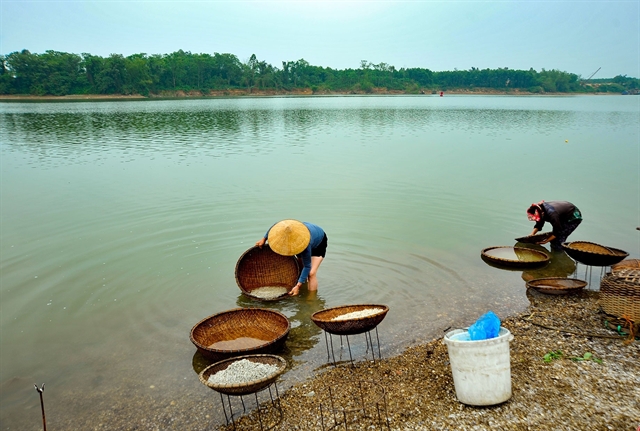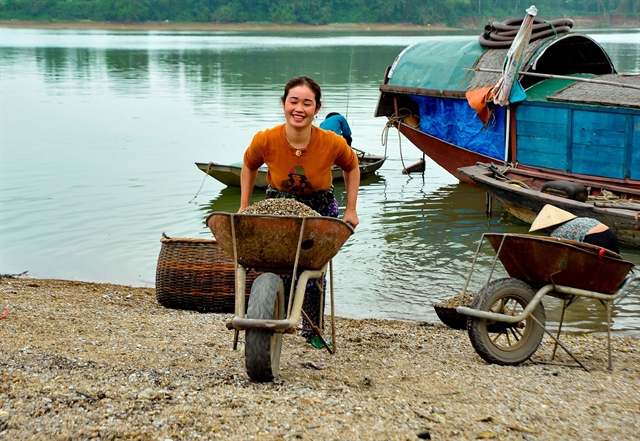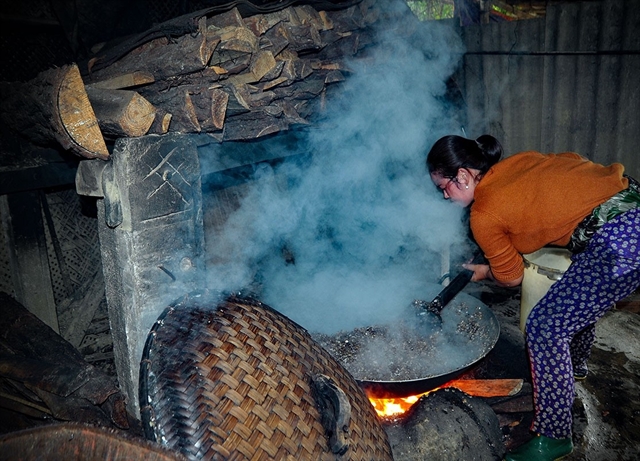 Sunday/Weekend
Sunday/Weekend

 |
| Sifting mussels by the La Giang River. — Photo baohatinh.vn |
Mussels have long been a specialty of the people of Bến Hến Village, which has more than 300 years of history.
The village is nestled on a section of the La River in Trường Sơn Commune, Đức Thọ District, Hà Tĩnh Province. Locals here make a living by raking mussels at the bottom of the river and then cooking them to sell.
These days, the section of the La River in the village is dyed with the colour of smoke emitted by the mussel cookers on the riverside. The savoury smell of mussels spreads throughout the town and serves as the indispensable flavour of the villagers.
The area for cooking mussels is about 300m long, running along the river shore. There are dozens of shacks, about 5sq.m wide, temporarily built with wooden poles and roofed with sheet metal or red and green canvas. In each shack, there is enough kitchen for a large cast iron pot to cook the mussels.
Trần Thị Trà Giang, 40, says that every day at 6pm, her husband rows a wooden boat, uses an iron rake or dives to harvest mussels on the river bed until 6am the next day. After that, she goes to the boat to pour mussels into a bamboo basket and soak them in the river for 6-7 hours to release all the dirt. In the early afternoon, she brings bamboo baskets containing mussels to the shack.
 |
| People take mussels from a boat to a makeshift kitchen to boil. — Photo baohatinh.vn |
Boiling mussels requires technique. Giang needs to put two or three buckets of water in a pan and then pour in about 10-15kg of mussels. When the water boils, white foam bubbles up. She has to use a large wooden spoon to stir it again and again, then takes out the bamboo basket. It takes about 20 minutes to cook. The pure mussel broth is also drained to make consommé, often sold with mussel flesh.
Freshly cooked mussels are placed in a basket and brought to the river for sifting. Each batch of mussels is sifted for 10 minutes. Giang then brings the mussel container ashore, places it on a slight incline to drain, and puts them in a plastic bag to sell to customers.
 |
| Boiling mussels. — Photo baohatinh.vn |
Each afternoon, a household can cook six pans of about 100-150kg of mussels in total.
Local Thái Thị Liêu says: “From every 100kg of raw mussels, I can get 10kg of mussel flesh, which is sold for VNĐ200,000 per kilogram. The price of mussel flesh in other rivers is lower, from VNĐ70,000-120,000 per kilogram. I sell about 20kg of mussel flesh every day.”
According to Liêu, the reason for such a price difference is that the mussels of the La River have a rich savoury taste, and are popular with many customers to make dishes such as porridge and white rice with mussels.
Đoàn Thị Minh, 70, often buys mussels from the village and then cooks them herself for sale at the market. “Every day, I buy 100kg of raw mussels in the village. I often gain a profit of VNĐ300,000 per day,” she says.
For Bến Hến villagers, if a household sells 10-15kg of mussel flesh, they will earn about VNĐ500,000 – VNĐ1 million in profit.
 |
| A local shows her finished products: mussel flesh. — Photo baohatinh.vn |
Locals also sell mussel shells to make animal feed and quicklime.
Selling these by-products not only makes economic sense but also helps solve environmental pollution problems.
In the past, the village had nearly 200 households in its traditional mussel trade, but now there are less than 80.
Nguyễn Văn Tuyến, chairman of Trường Sơn Commune People's Committee, says mussels in the La River are increasingly scarce, so the villagers sometimes have to go to other rivers to find them. VNS




